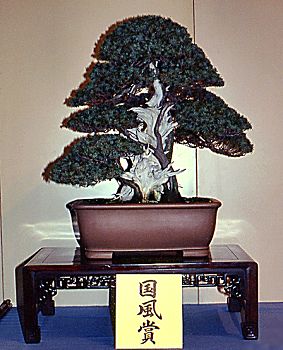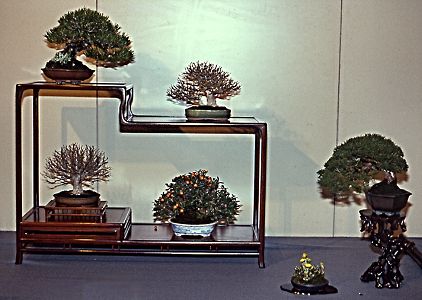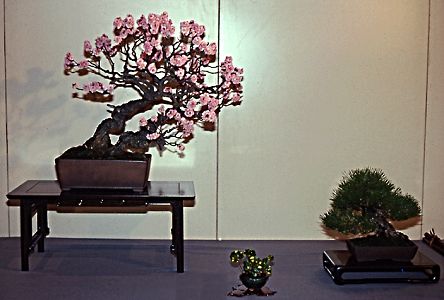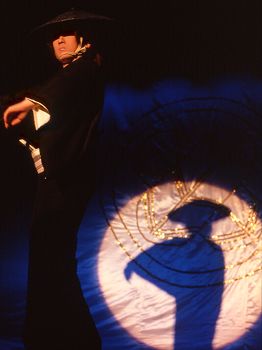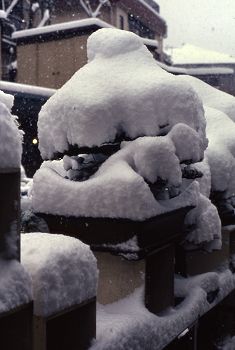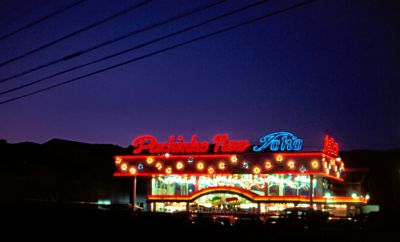
Our neighborhood Pachinko parlor.
Larger version
I had merely intended to observe, but Mitsuyasan insisted I play – and he thrust a ¥500 (about US$4.25) coin into my hand. So what's a girl to do? I put the coin in the slot, received a handful of metal balls, and put them to work. The Pachinko is like a vertical pinball: you shoot the ball to the top and gravity brings it down. One hopes it takes the scenic route – banging and bouncing off obstacles, setting off bells and whistles that indicate all the points you are collecting. These points are converted into more marble-sized metal balls that spill out like coins from a slot machine.
But I was not to see any action from my machine. In record time, I wasted two coins. Mitsuyasan wasn't doing any better, so I took off to see how the others were faring. Kensaku never saw me as he focused on feeding the hungry kitty that wasn't purring. But in the next aisle, Okusan (Mrs. Mitsuya) was on a winning streak. I looked over her shoulder to admire her skill, but she grabbed a double handful of balls and put me to work. Soon my machine was singing as loudly as hers. Before long I needed a plastic shoe-box-sized container to hold the overflow of metal balls. Within 20 minutes I'd filled it while Okusan lost all of hers.
Mitsuyasan and Kensaku had also come up empty-handed, so we departed, but not before collecting my winnings. It is illegal to exchange the balls for money (which many people manage to do nonetheless), so the balls are counted or weighed and you choose from an array of items from the "Pachinko store." My shoe box of balls was traded for four cartons of cigarettes (for the now ex-smoker Mitsuyasan) and twelve bags/boxes of snack foods. Finally, a skill I'm good at.
The Japanese are fond of gambling, whether it be Pachinko, boat races, bimonthly sumo tourney, or the Kokufu Bonsai Show. The 248 displays at the 68th annual show comprised only 40% of the bonsai that were presented before judges one month earlier. The bonsai master's gamble is to prepare a tree that will please the judges and find a spot in the most prestigious bonsai show of the year. This year, Mitsuyasan prepared seven entries for consideration. Four of our trees made it into the show.
Two trees were stately kuro matsu (black pine). One was a formal upright, quite symmetrical, in a very shallow pot. The other was a magnificent slant-style. Ishizusan, who has a fabulous suiseki collection, submitted an elegant multiple-trunk momiji (Japanese maple). The largest tree: a powerful han kengai (semi-cascade) goyo matsu (five-needle pine).
Three months before the Kokufu show, we traveled to the old town of Odawara to pick up one tree and prepare it. Umebarasan does not have many trees, but his small collection includes several gems. We arrived on a crisp November morning. Before our arrival, a gentle rain cleansed the pristine garden, intensifying the vibrant colors of fall. Everyone's eyes were glued to one particular tree – last year's entry in the Kokufu show. The kaede no ishizuke (trident maple over rock) displayed a gorgeous array of warm colors that melted our hearts.
After the big goyo matsu was loaded into the van, we headed home. Yochan did most of the detail work to prepare this tree for the show. This usually involves cleaning old or damaged foliage/needles, replacing unsightly moss on the surface of the soil, and cleaning the pot. Also, taking steps to minimize obvious defects is in order.

Goyo matsu, styled by Mitsuyasan.
Details and larger version
This tree had a significant amount of shari (dead wood on the trunk). There were two places where wood had rotted and repairs had been made. The removal of the damaged wood left holes that were then filled with cement. The color of the cement blended well with the dead wood and prevented further destruction of the trunk. But the cement was a blemish that would not survive the scrutiny of the Kokufu judges, so an adroit application of lichen and moss successfully concealed the flaw.
The momiji needed the least amount of attention before the show. This tree had been displayed at the Taikanten show in Kyoto just three months earlier, so it was quite beautiful. After the removal of a few dead twigs, this tree was back in its prime. Yours truly got the pleasure of applying moss to the surface soil of the two kuro matsu. I scrounged around the nursery to collect the most desirable moss – grayish, compact, and not too thick. There were many variations in the moss collected; when applied with care, the green carpet had a patchwork quality that looked quite natural.
Yochan, keeping an eye on me (as usual), offered me a useful
tip. The application of moss can create a visual illusion to hide a
flaw. For instance, if the nebari (surface roots) of a tree
are not radial, moss can be used create the visual illusion of nice
nebari.

Diagram A Diagram B
In diagram A, the tree is lacking surface roots on the right side. In diagram B, the application of moss extending out from the tree gives the illusion of surface roots where there are none – a simple but effective trick. If the entire soil surface is to be covered in moss, a darker green moss near the tree and a lighter, gray-green moss near the edge of the pot will give the same effect.
Fortunately, both kuro matsu I prepared for the show were outstanding, so my job was easy. But just before transporting the trees to Tokyo for the judging, the needles of the formal upright were trimmed. They were uneven in length, but a sharp pair of scissors gave them uniformity in no time. This job is performed just before the judging of a show, because the cut ends will eventually turn brown. The needles of the slant style were long (almost 4") but even, so they were untouched.
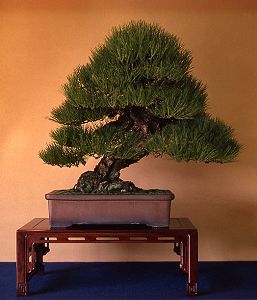
Kuro matsu, styled by Mitsuyasan.
Details and larger version
About three weeks transpired between the judging and the show. So before we gently crammed the van with our Kokufu treasures, we cleaned off any dead needles and polished the pots. The next morning, we began our pilgrimage to Tokyo for the finest show of the year. We were on the road by 4 am and rolled into Ueno Park by 8:30 am.
The Kokufu show is housed on two basement floors of the Tokyo Metropolitan Museum. The lowest level contained all the large bonsai, which comprised the majority of displays as well as all our entries. The upper floor showcased the shohin and small bonsai. I liked the organization of the show: the grouping of trees by size prevented the overpowering of some bonsai by proximity to others.
